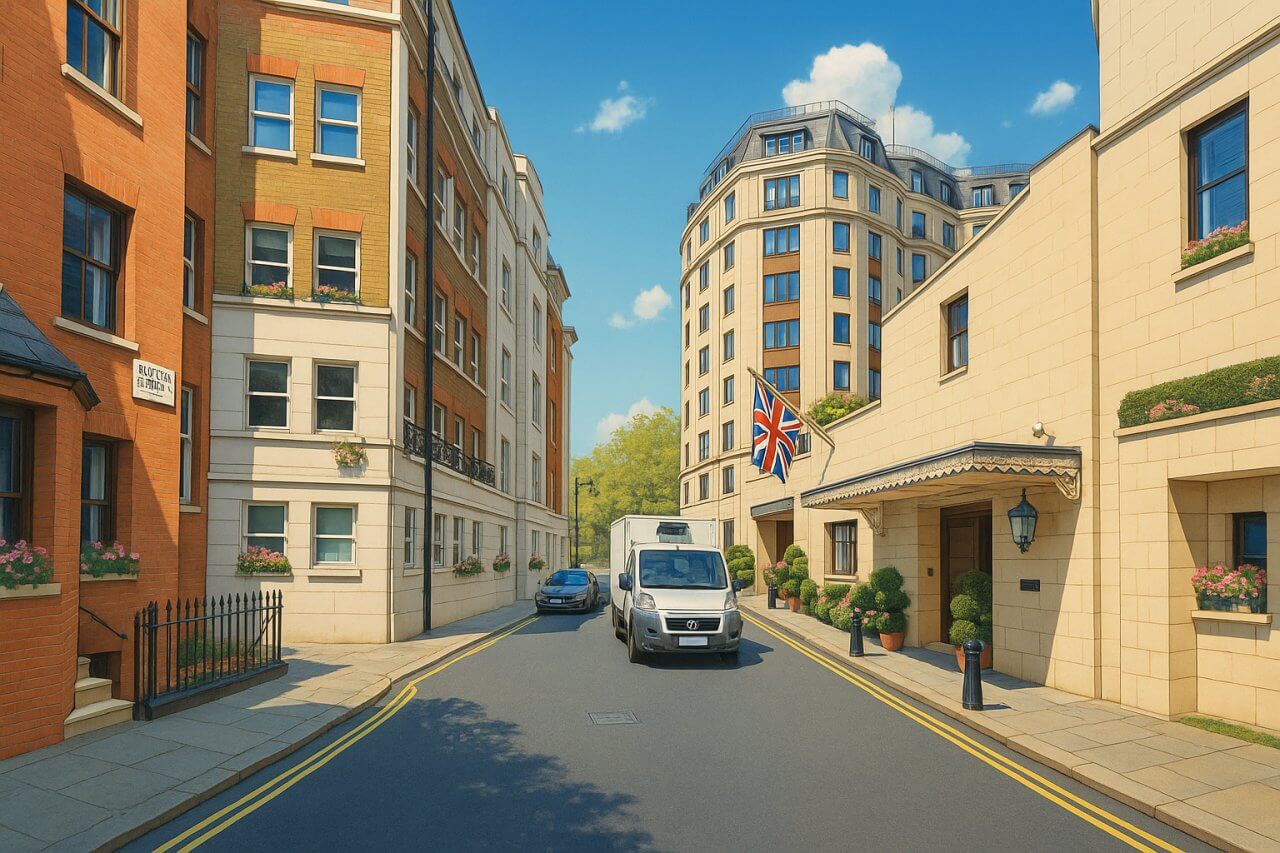
Deanery Street, London
Deanery Street is a short but exclusive one-way street in Mayfair, located within the City of Westminster, London. It runs northbound from its southern junction with Park Lane and Stanhope Gate to its northern junction with South Audley Street and Hill Street. Branching from Deanery StreetThough it spans just a few hundred feet, the street encapsulates the elegance and prestige associated with Mayfair’s historic urban layout.
Street Layout and Surroundings
Deanery Street runs in a one-way northbound direction and sits neatly between two major arteries of Mayfair. Its southern end connects directly with Park Lane—a key thoroughfare bordering Hyde Park—and Stanhope Gate, while its northern end links to South Audley Street, a street well-known for its luxury boutiques and refined townhouses. To the west is Hill Street, and beyond that lies the heart of Mayfair’s residential and diplomatic quarter.
The street itself is primarily lined with low-rise luxury apartment blocks and elegant townhouses, many of which feature private entrances, concierge services, and underground parking. Despite being in such a central and well-trafficked part of London, Deanery Street feels quiet and residential, buffered from the noise of Park Lane by its backstreet positioning and tree cover.
History and Name Origin
Deanery Street was developed in the early 19th century as part of the broader urbanisation of the Grosvenor Estate in Mayfair. The name "Deanery" is believed to be derived from a former ecclesiastical connection, possibly referencing the Dean of Westminster, given the proximity to Westminster Abbey and the influence of church landholdings in the area during earlier centuries.
The surrounding estate was carefully planned to attract aristocratic and upper-class residents during the Georgian and early Victorian periods. Over time, the street has retained its upscale character, with much of the original architectural styling either preserved or sympathetically redeveloped to suit contemporary luxury standards.
Local Sights and Attractions
While Deanery Street itself is primarily residential, it benefits from immediate proximity to some of Central London’s finest attractions. Just a minute’s walk away is Hyde Park, one of the largest and most popular green spaces in London. Grosvenor Square, a historic garden square that once housed the American Embassy, lies nearby to the north.
Nearby South Audley Street is known for its designer boutiques, antique shops, and the iconic Audley Public House, a restored pub that combines heritage interiors with upscale dining. The district of Mayfair also offers numerous art galleries, private clubs, and hotels such as The Dorchester and 45 Park Lane.
Real Estate and Property Market
Deanery Street is among the most exclusive residential locations in Central London. As of June 2025, properties on the street typically range from £3.5 million for a 2-bedroom flat (approx. 1,300 sq ft / 121 sq m) to upwards of £8 million for larger maisonettes or townhouses exceeding 3,000 sq ft (278 sq m). Prices here are significantly higher than the London average, reflecting the street’s prestige and the desirability of the Mayfair address.
Buyers are often attracted by the discreet setting, security, and access to high-end amenities, with many homes offering private lifts, concierge services, and secure underground parking—luxuries rare even in central London.
Transport Connections
Nearest London Underground Stations
The closest London Underground Stations to Deanery Street are:
- Green Park Station – served by the Piccadilly Line, Jubilee Line, and Victoria Line (approx. 7 minutes' walk)
- Bond Street Station – served by the Central Line and Jubilee Line (approx. 10 minutes' walk)
Other nearby stations within walking distance include Oxford Circus Station and Piccadilly Circus Station, both offering extensive connectivity across London.
Bus Stops and Services
The nearest bus stops are located along Park Lane and Piccadilly, offering several daytime and night services connecting to key areas such as Oxford Street, Knightsbridge, and Victoria. Routes include numbers 2, 6, 16, 23, 36, and 148, among others. These stops provide fast access to the West End and major rail stations.
Fun Fact
Deanery Street was once home to famed art dealer and gallery owner Sir Joseph Duveen, who helped shape collections at the British Museum and Tate Britain. Although the original house no longer survives, it’s a testament to the street’s long-standing association with the cultural elite of London.
Quick Facts
- Location: Mayfair, City of Westminster, London
- Postcode: W1K
- Street Type: One-way, northbound
- Connects: Park Lane and Stanhope Gate (south) to South Audley Street and Hill Street (north)
- Nearest Tube Stations: Green Park, Bond Street
- Underground Lines: Piccadilly, Jubilee, Victoria, Central
- Nearby Bus Routes: 2, 6, 16, 23, 36, 148
- Notable Nearby Sights: Hyde Park, Grosvenor Square, South Audley Street
- Average Property Prices (2025): £3.5M–£8M
- Property Sizes: 1,300–3,000+ sq ft (121–278 sq m)
- Historic Detail: Named for likely ecclesiastical connection, 19th century development
- Fun Fact: Once home to renowned art dealer Sir Joseph Duveen
References
- Rightmove – Deanery Street Property Listings (June 2025)
- City of Westminster Planning Archives
- Londonist – Historic Streets of Mayfair
Map of Deanery Street, London
 Painting of Deanery Street, London
Painting of Deanery Street, London